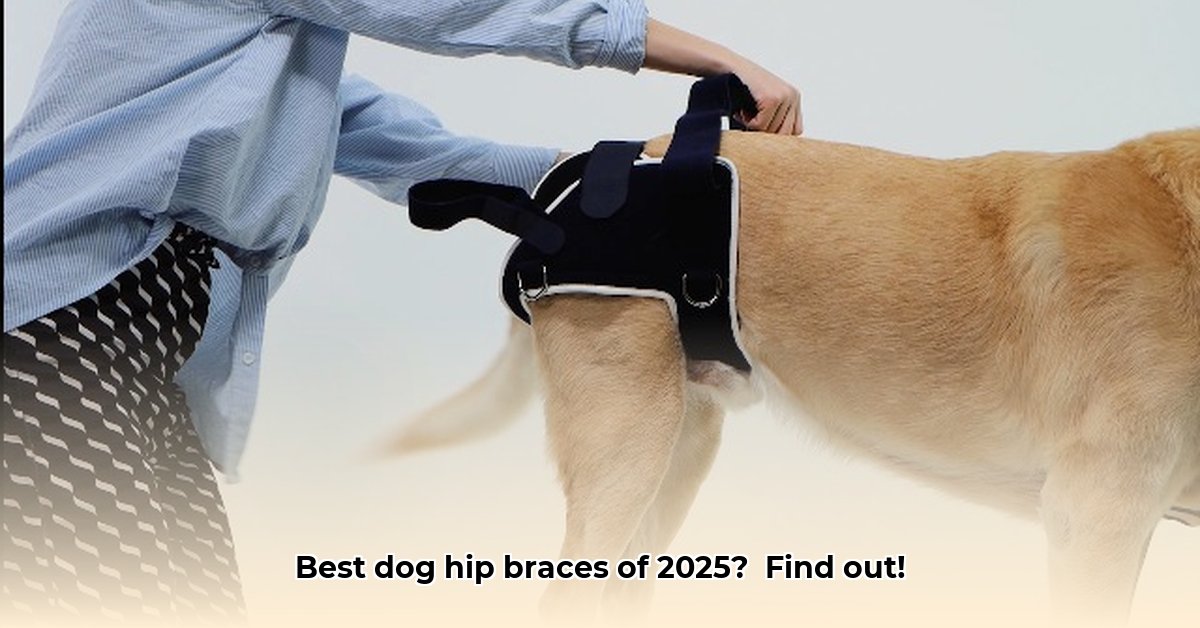Is your dog limping or showing signs of hip pain? A hip brace could offer much-needed support and pain relief! However, with the market flooded with options, selecting the right one can feel overwhelming. This comprehensive guide provides a detailed comparison of different brace types, step-by-step instructions for measuring your dog, and essential usage and care tips. Crucially, we highlight the need for veterinary consultation prior to use. For information on related hind leg issues, see our guide on shaking back legs. Let’s empower your canine companion to move comfortably again!
Dog Hip Brace: Your 2025 Guide to Choosing the Right Support For Canine Hip Dysplasia and Arthritis
Selecting the right dog hip brace can indeed feel daunting, with countless options promising relief for your beloved furry friend. To choose a brace that caters to your dog’s needs, let’s explore each step together for managing canine hip dysplasia and arthritis.
Understanding Your Dog’s Hip Pain – The First Step For Canine Comfort
Before considering braces, consult a veterinarian. They’ll diagnose the underlying cause of your dog’s discomfort. This can include hip dysplasia, arthritis, degenerative joint disease, or a torn CCL (cranial cruciate ligament, analogous to the human ACL). Your vet will also confirm if a hip brace is suitable for your dog’s situation. Skipping this vital step could lead to wasted money on ineffective braces and, potentially, cause harm.
Types of Dog Hip Braces: A Head-to-Head Comparison For Canine Joint Support
Dog hip braces differ in shapes, sizes, materials, and levels of support. Below is an overview of some key differences to help you choose the right one for canine joint support:
| Feature | Neoprene Brace | Breathable Mesh Brace | Rigid Brace | Flexible Brace | Hip Support System |
|---|---|---|---|---|---|
| Material | Snug, warm neoprene; good compression. | Lightweight, airy mesh; keeps things cool. | Usually sturdy plastic or metal. | Flexible fabrics, often with supportive elements. | Combination of fabrics and rigid supports. |
| Pros | Affordable; good for mild discomfort. | More comfy, especially for active dogs. | Strong support for serious issues. | Adapts to your dog’s movement; generally comfy. | Maximum support and stability. |
| Cons | Can get hot; might not be breathable enough. | May not offer enough support for severe issues. | Can be bulky and feel restrictive. | Might not provide enough support for severe cases. | Can be expensive. |
| Best For | Mild hip dysplasia; some arthritis cases. | Moderate hip dysplasia; post-op recovery. | Severe hip dysplasia; torn CCLs. | Mild to moderate conditions; everyday use. | Severe cases, post-surgical recovery. |
Here’s a more detailed look:
- Neoprene braces: Offering warmth and compression, they’re a good choice for mild discomfort and arthritis. They may not be ideal for warm climates or highly active dogs due to potential overheating.
- Breathable mesh braces: The airy design prevents overheating, making these perfect for active dogs or those in warmer climates. They generally provide less support than rigid braces, focusing on comfort and mobility.
- Rigid braces: Offering strong structure and support, these heavy-duty options are often chosen for severe conditions like a torn CCL or advanced hip dysplasia where significant stabilization is needed. They might restrict movement a bit and require a period of adjustment for the dog.
- Flexible braces: Striking a balance, they offer good support without being too restrictive, making them adaptable to your dog’s movements for everyday use. They may not be suitable for severe cases requiring substantial immobilization.
- Hip Support Systems: These often incorporate a harness with leg attachments, providing comprehensive support to the hip joint and surrounding muscles. They’re suitable for dogs with significant mobility issues or those recovering from surgery.
Choosing the Right Brace: A Step-by-Step Guide For Optimum Canine Comfort
- Accurate Measurements: Follow the manufacturer’s instructions precisely. Incorrect sizing compromises brace effectiveness and can lead to discomfort or injury. If unsure, get assistance from your vet or a professional at a pet supply store. Measure chest, height, and thigh circumference for the best fit.
- Condition Assessment: Rely on your vet’s diagnosis. A torn CCL requires a different brace compared to mild arthritis or hip dysplasia. Understand the specific needs of your dog’s condition.
- Lifestyle Considerations: Energetic dogs need braces that allow freedom of movement, while less active seniors might benefit from more supportive but less restrictive options. Consider your dog’s daily activities and choose a brace that accommodates their lifestyle.
- Comfort is Key: The brace should fit snugly without restricting movement or causing irritation. Regularly inspect for rubbing or chafing, especially in the groin and armpit areas.
Fitting and Using the Brace: A Gentle Approach For Canine Care
- Proper Fit is Paramount: The brace should fit comfortably without hindering your dog’s natural gait. Too loose is ineffective; too tight causes discomfort and potential skin issues. Ensure proper alignment and adjust straps accordingly.
- Gradual Introduction: Avoid immediate, prolonged brace use. Start with short periods (15-20 minutes) and gradually increase the duration as your dog adjusts. Positive reinforcement (treats and praise) can help your dog acclimate to the brace.
- Constant Monitoring: Watch for signs of skin irritation, such as redness, swelling, or chafing. Remove the brace regularly for thorough skin inspection, especially after exercise or outdoor activities. Seek immediate veterinary advice for any concerns.
- Proper Placement: Ensure the brace is correctly positioned according to the manufacturer’s instructions. The support should be focused on the hip joint, providing stabilization without restricting leg movement.
Brace Care: Keeping It Fresh and Functional For Long-Term Use
Regular cleaning is essential to prevent bacterial buildup and skin irritation. Follow manufacturer’s advice, typically involving hand washing with mild soap and air drying. Avoid harsh chemicals or machine washing which can damage the brace materials. Regularly inspect the brace for wear and tear, such as frayed straps, loose closures, or damaged padding. Replace the brace if it shows signs of significant wear.
Important Considerations: Beyond the Brace For Canine Well-being
Dog hip braces supplement veterinary treatment plans, they don’t replace them. They aren’t a magic cure. A holistic approach to managing hip dysplasia and arthritis may include weight management, controlled exercise, joint supplements, and pain medication. Some dogs can experience skin reactions or irritations from brace materials. Always involve your vet. Because every dog is an individual, the perfect brace fits individual needs. Veterinary guidance ensures optimal support and care for your furry companion. Stay informed and consult your vet regularly, as research evolves.
How to Choose the Best Dog Brace for Hip Dysplasia Based on Breed and Severity For Targeted Relief
Key Takeaways:
- Hip dysplasia braces offer pain relief and improved mobility, but more research is needed regarding their long-term effectiveness.
- Brace selection varies based on breed, size, activity level, and dysplasia severity.
- Proper fit is crucial; improper sizing causes discomfort or ineffective support.
- Materials (neoprene, mesh) and design features (padding, adjustable straps) affect both comfort and support.
- Different braces suit various dysplasia stages (post-surgery vs. chronic).
- Costs can vary significantly.
- Veterinary guidance remains essential throughout the entire process.
Understanding Your Dog’s Needs For Tailored Support
Before exploring specific brace types, clarify the essentials for how to choose the best dog brace for hip dysplasia based on breed and severity:
- Breed: Larger breeds often are predisposed to hip dysplasia. Their size influences brace design and material needs. A Great Dane needs a brace different from that of a Chihuahua. Certain breeds, like German Shepherds, are also prone to degenerative joint conditions.
- Severity: Is your dog experiencing mild discomfort, intermittent limping, or significant mobility limitations? Matching the brace’s level of support to your dog’s needs is essential. There are differences for mild and post surgical dysplasia.
- Activity Level: Active dogs may require a more robust and durable brace than less active dogs. A highly active dog may need a brace with reinforced stitching and more durable materials.
- Your Vet’s Assessment: Your vet will diagnose severity, recommend brace types, and ensure proper fit. They can also evaluate if there are other underlying conditions contributing to the hip pain.
Types of Hip Braces: A Comparison For Effective Outcome
Several brace types exist, each with its own advantages and disadvantages:
| Brace Type | Material | Pros | Cons | Best Suited For |
|---|---|---|---|---|
| Supportive Braces | Neoprene, Mesh | Comfortable, good for mild dysplasia | Limited support for severe cases | Mild dysplasia, preventative measures |
| Compression Braces | Neoprene | Improves blood flow, reduces swelling | Potential for over-compression | Post-surgery, managing inflammation |
| ROM (Range of Motion) Braces | Various Materials | Increased range of motion, support | Can be bulky, might restrict movement | Moderate to severe dysplasia, post-op |
| Hip Lifting Harnesses |
- Where to Buy Bento Boxes for Healthy, Organized Meals - December 9, 2025
- Plastic Bento Boxes Make Meal Prep and Cleanup Effortless - December 8, 2025
- Shop Bento Lunch Boxes on Sale Nearby Now - December 7, 2025










